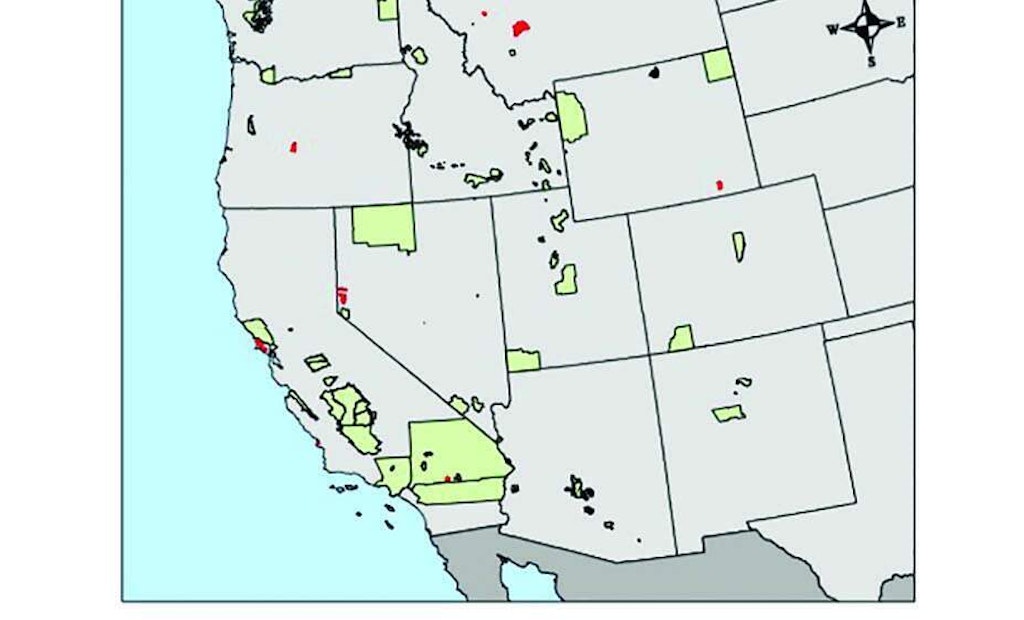
This map created by the author shows areas of conflict over nitrate and septic systems in the Western U.S. Red indicates septic system nitrate conflict. Green indicates septic system nitrate issue interest.
In Deschutes County, Oregon, the Board of County Commissioners adopted regulations in 2008 that required residents to connect their homes to sewer or upgrade their septic systems to advanced treatment systems by 2022. The commissioners were concerned because some areas had shallow groundwater, soils with high infiltration rates, and the population had grown almost 54% from 1990 to 2000.
The following year in a special election, residents voted for the regulations to be remanded. The residents felt the cost of the upgrades were unjustified since the water from their wells looked, tasted and smelled clean. This is one event in decades of political conflict.
The Deschutes County conflict is not unique, there are political conflicts over nitrate from septic systems across the Western U.S. I became involved in these political conflicts in La Pine, Oregon, (in Deschutes County) and Laramie, Wyoming, while I was completing my PhD work at Oregon State University. I created a map because the residents I spoke to in La Pine and Laramie wanted to find other communities with septic system issues, to compare themselves to other communities. The map only includes communities up to the county size and does not include states with stricter septic system laws such as Colorado.
NITRATE PRIORITY AREAS
It was harder to find places with septic system nitrate issues since; it was overshadowed by other issues, the area affected were often the size of a neighborhood or town and many of the documents are not searchable online. However, it was easy to find a few high-profile cases like the Enhanced Management Areas around Puget Sound, Washington, that are often mentioned in the Rules & Regs section of Onsite Installer.
In many of the areas marked on the map, conflict was minimal and nitrate from septic systems was only mentioned in passing. For example, Nitrate Priority Areas were delineated by the Idaho Department of Environmental Quality but the source of nitrate was not identified so common nitrate sources were listed which included septic systems. Another example is the Central Valley in California, where the main source of nitrate is from agriculture, so the focus is on agricultural practices or finding new water sources instead of septic systems.
In some areas the government took a softer approach to septic system nitrate often through the use of funds or planning. For example, in Teton County, Wyoming, funding was provided through a U.S. Environmental Protection Agency grant for septic system pumping and inspection. Planning comes in two forms: voluntary guidelines (plans) on the location of specific types of development like in Albany County, Wyoming and minimum lot sizes (often more than 5 acres) to dilute the effect of septic systems on groundwater like Washington County, Utah.
In areas like Deschutes County, the conflict is often over actions taken by regulators that would radically change the septic system landscape. Besides advanced treatment systems and sewer connection, other controversial actions include sewer construction/expansion, halting development, development moratoriums and stricter development regulations.
GOOD AND BAD OF REGULATIONS
Conflicts can cause regulations to shift from year to year as regulators take different approaches on the issue. The volatility of the regulations can cause delays and misunderstandings. In one instance charges were brought against a septic system installer because the company was constructing onsite systems without a permit. The installer’s counter argument was that they had sent in the paperwork over a year ago and contacted the government multiple times without a response. Other areas that have experienced septic system conflict include: Laramie, Wyoming, Los Osos, California, West Marin/Sonoma County and Yucca Valley, California, Seeley Lake, Montana and Reno/Carson City, Nevada.
The politics of nitrate from septic systems is both good and bad for onsite wastewater treatment businesses. The good is that there is more business if the law requires more inspections or funds are available for septic construction and maintenance. Also, advanced treatment systems require more frequent inspection and maintenance. The bad is that pumpers can lose business if residents are forced to connect to sewer or lose potential business if development is halted. Fluctuating rules add more steps and delays to any project.
Though there are conflicts over groundwater contamination from septic systems across the U.S., at the end of the day residents, the government and onsite wastewater treatment businesses all want to do right by each other.
David Demaree graduated from the Environmental Science PhD program at Oregon State University and is currently a postdoctoral fellow with the U.S. EPA through the Oak Ridge Institute for Science and Education in Athens, Georgia. His dissertation is on the science and political conflicts of nitrate contamination of groundwater by septic systems and can be found at the following link:
ir.library.oregonstate.edu/concern/graduate_thesis_or_dissertations/zc77sx16v?locale=en
Funding for the project was provided by the Deschutes County Citizens Action Group, Central Oregon LandWatch and the Casper Aquifer Protection Network. The views described in the articles represent the views of the author and do not represent the views of the affiliates.






